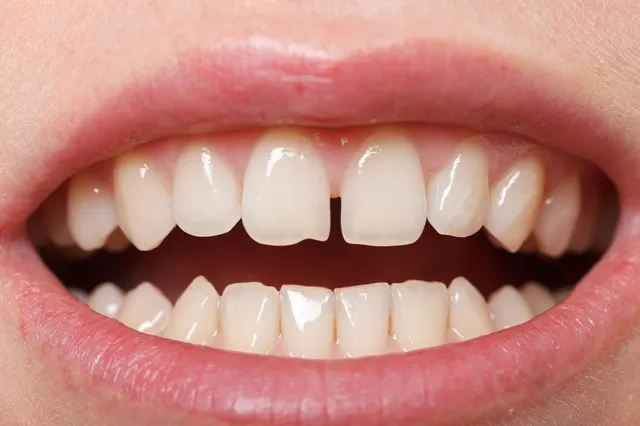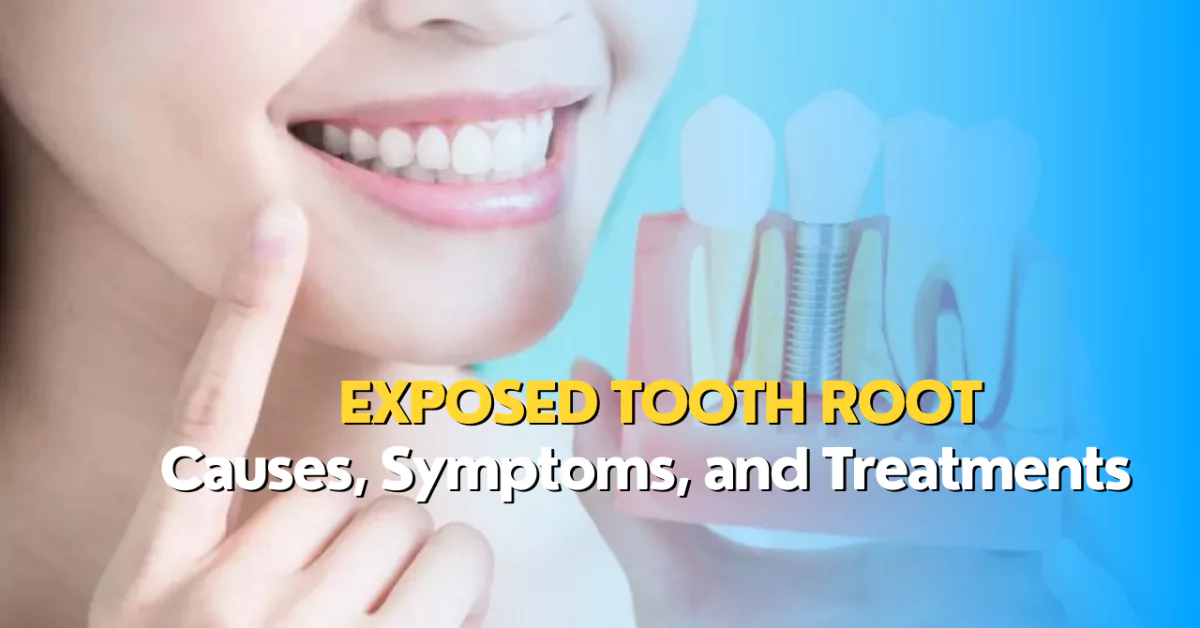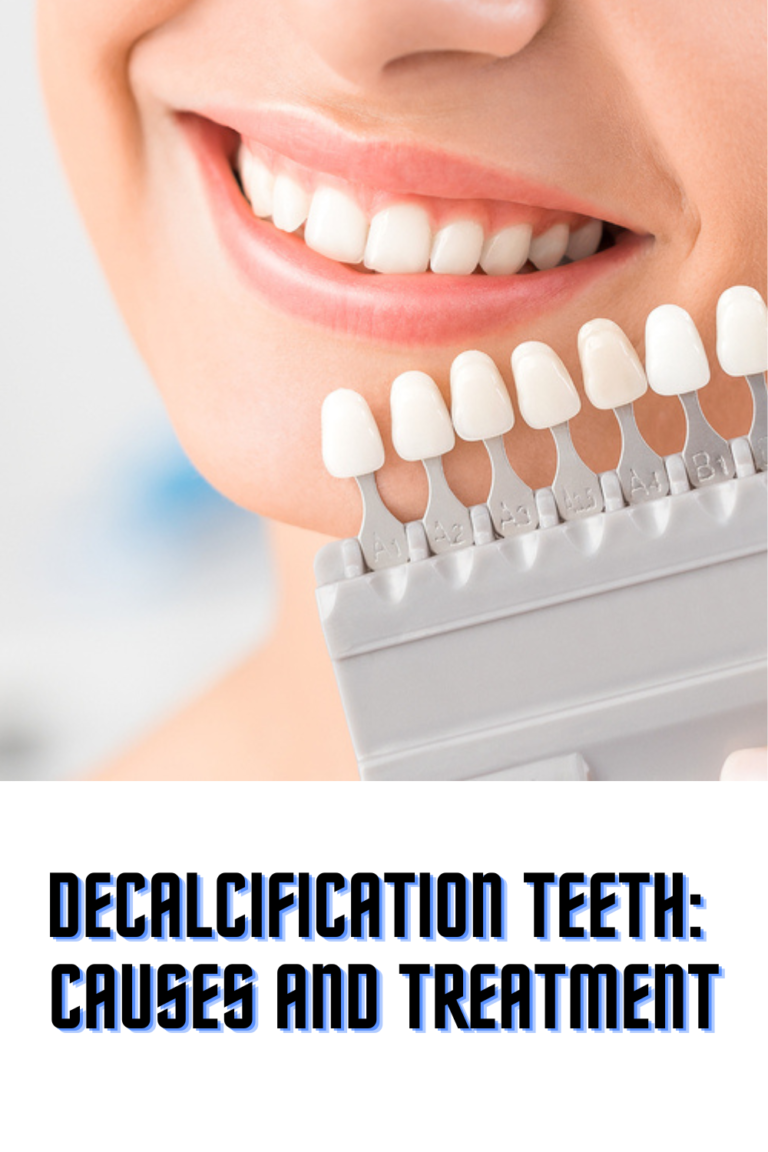Exposed Tooth Root – Causes, Symptoms, and Treatments
Have you ever felt a sharp pain in your tooth when you drink something hot or cold? Or noticed your gums are receding and your teeth look longer than before? If so, you might have an exposed tooth root.
An exposed tooth root is a condition where the protective layer of enamel that covers the basis of your tooth wears away. Left untreated can cause discomfort and tooth loss. The article will explain the causes, symptoms, and treatments available to restore oral health and smile.
Also Read: Do Whitening Strips Work? Types and Tips for Effective Results
Teeth Roots Exposed: What’s Going Onffill?
Your teeth comprise two main parts: the crown and the root. The crown is the visible part of your tooth that you use to chew and smile. The root is the part that extends into your jawbone and anchors your tooth.
The crown of your tooth is covered by a hard layer of enamel, which protects it from decay and damage. The root of your tooth is covered by a softer layer of cementum, which helps to seal the root canal and prevent infection.
Both enamel and cementum are supported by a layer of dentin, which is a porous material that contains nerve endings and blood vessels. Dentin is sensitive to temperature, pressure, and acidity, so it needs to be protected by enamel or cementum.
When the enamel or cementum wears away or gets damaged, the dentin becomes exposed to external stimuli, such as hot or cold drinks. It results in pain and infection in the tooth and surrounding tissues.
Recognizing When A Root Is Exposed
An exposed tooth root can affect any tooth in your mouth, but it is more common in the back teeth because they bear more pressure when you chew. It can also affect the canine teeth (the pointed teeth) because they are more prone to trauma.
Some signs that you might have an exposed tooth root are:
- Longer-looking tooth
- Tooth discolouration
- Sensitivity
- Swollen gums and foul smell
- Tooth discomfort
- Pain in the jaw
- Pain when chewing
- You can’t clean your teeth as well
- You’ve Got a Bad Bite
- A loose tooth
- Infection
Causes of Exposed Tooth Roots

Many factors can cause exposed tooth roots, such as:
Gum Disease
The condition known as gum disease is an infection of the gums brought on by plaque. Gum disease can cause your gums to slip away from your teeth and create pockets where bacteria can flourish. It can lead to gum recession and exposed tooth roots.
Receding Gums
Receding gums are when your gums shrink or move away from your teeth, exposing more of the root. It can be caused by gum disease, aging, or other factors.
Harsh Brushing
Brushing your teeth using a toothbrush with stiff bristles can wear away the enamel or cementum and expose the dentin.
Tooth Grinding
Tooth grinding (bruxism) is when you clench or grind your teeth, usually during sleep or stress. It can cause excessive pressure and friction on your teeth, wear away the enamel or cementum, and expose the dentin.
Trauma
Trauma is when you injure your tooth or gums due to an accident, injury, or violence. It can cause cracks, chips, or fractures in your tooth or gums that expose the root.
Orthodontic Work
Orthodontic work is when braces, aligners, or other devices are used to straighten your teeth. It can cause your gums to recede or shift as your teeth move into new positions. You should follow your orthodontist’s instructions on caring for your teeth during and after treatment.
Misaligned Teeth
Misaligned teeth are when your teeth are crooked, crowded, or spaced out. It can cause uneven pressure and wear on your teeth and gums and expose the root. You may need orthodontic work to correct your alignment and prevent further damage.
Tobacco Use
Tobacco use can stain teeth, irritate gums, and increase gum disease and cancer risk. It can lead to gum recession and exposed tooth roots. You should quit tobacco use for your oral and overall health.
Tooth Decay
Tooth decay is when bacteria in plaque produce acids that erode your tooth’s enamel and create cavities (holes). If the decay reaches the dentin or the pulp, it can cause pain, sensitivity, infection, and exposed root.
Exposed Tooth Root Treatments

The treatment for an exposed tooth root depends on the condition’s cause, severity, and location.
Some of the possible treatments are:
Root Canal Therapy
Root canal therapy is when the dentist removes the inflamed pulp inside the tooth and fills the root canal with a rubber-like material called gutta-percha. It seals off the root canal from bacteria and prevents further infection.
Removal of the Tooth
Removal of the tooth (also called extraction) is a procedure where the dentist pulls the tooth from its socket using forceps or surgical instruments. It is usually done as a last resort when the tooth is too damaged.
Removal of the tooth can stop pain and infection caused by an exposed root. However, it can also cause problems such as bone loss.
Crown
To restore a tooth’s form, functionality, and look, a crown is placed over the broken portion of the tooth. It is made of materials that are similar in colour to natural teeth. A tooth with an exposed root can be shielded with a crown from additional harm or decay.
Flap Surgery
Flap surgery is when the dentist lifts the gum tissue around the affected tooth and removes any plaque, tartar, or infected tissue. The dentist then repositions the gum tissue over the root and stitches it in place.
Flap surgery can treat gum disease that causes gum recession and exposed tooth roots.
Gingival mask
A gingival mask is a removable device that covers the exposed root and gum tissue. It is made of silicone or acrylic material that matches the colour of natural gums. A gingival mask can hide the appearance of an exposed root and improve the aesthetics of your smile.
Gum Graft
A gum graft is a procedure where the dentist takes a piece of tissue from another part of your mouth (usually the palate) and attaches it to the receded gum area. It adds more tissue to cover the exposed root and restore the gum line.
Dental scaling
Dental scaling is a procedure where the dentist uses a unique tool to scrape off plaque and tartar from above and below the gum line. It removes bacteria and toxins that cause gum disease and inflammation. Dental scaling can prevent or treat gum disease that causes gum recession and exposed tooth roots.
Prevention Techniques for Exposed Tooth Roots
The best way to prevent exposed tooth roots is to care for your teeth and gums.
Some of the prevention techniques are:
- Limit your fluoride intake: A mineral called fluoride builds your enamel and guards against tooth decay. Fluorosis, which weakens your enamel and makes it more vulnerable to erosion and exposure, results from too much fluoride.
- Get your bite checked: Your bite is how your upper and lower teeth fit together when you close your mouth. If your taste is misaligned, it can cause uneven pressure and wear on your teeth and gums and expose the root.
- Use soft-bristled toothbrushes: You should use a soft-bristled toothbrush to clean your teeth. Hard-bristled toothbrushes can damage your enamel or cementum and expose the dentin.
- Protect your gums: You should protect your gums from injury by avoiding biting your nails, chewing on pens, or using toothpicks.
- Avoid tobacco: Tobacco use can stain teeth, irritate gums, reduce blood flow to your mouth, and increase gum disease and cancer risk.
- Brush and floss your teeth: You should brush your teeth twice daily with fluoride toothpaste. It can prevent gum disease, tooth decay, and exposed tooth roots.
What Happens to Untreated Exposed Tooth Roots?
If you have an exposed tooth root and do not seek treatment, you may experience serious complications such as:
- Severe pain and sensitivity
- Infection
- Abscess
- Tooth loss
- Bone loss
- Shifting of adjacent teeth
- Difficulty chewing
- Speech problems
- Aesthetic issues
Can an Exposed Tooth Root Be Treated at Home?
There is no definitive cure for an exposed tooth root at home. However, some home remedies can help you manage the symptoms.
Some of the home remedies are:
- Rinse your mouth with warm salt water or mouthwash formulated with fluoride or chlorhexidine. It can aid in lowering mouth sensitivity, infection, and inflammation.
- Put an ice pack or cold compress on your jaw or cheek. It may aid in relieving your mouth’s pain and swelling.
- Use over-the-counter analgesics like acetaminophen or ibuprofen. It can aid in reducing mouth pain and discomfort.
- Avoid foods and drinks that can trigger or worsen your symptoms, such as hot, cold, sweet, or sour foods and beverages.
- Eat soft foods like yoghurt, soup, mashed potatoes, or scrambled eggs.
- Use a desensitizing toothpaste with potassium nitrate or strontium chloride. It can help to block the nerve signals that cause pain and sensitivity in your tooth.
When to See a Dentist?
You should see a dentist instantly if you have any of the following symptoms of an exposed tooth root:
- Swelling, bleeding, or infection in your gums
- A loose or wobbly tooth
- A longer-looking or discoloured tooth
- A lousy bite or difficulty chewing
Frequently Asked Questions (FAQs)
Can a tooth with an exposed root be saved?
A tooth with an exposed root can be saved in most cases. Depending on the cause, severity, and location of the condition, your dentist may suggest one or more of the following treatments to save your tooth:
- Root canal therapy
- Crown
- Flap surgery
- Gum graft
- Dental scaling
- Root planing
These treatments can protect your tooth from further damage or decay, relieve pain and sensitivity, and restore oral function and appearance.
Does removing a root hurt?
Removing a root (also called extraction) is when the dentist pulls out the tooth from its socket using forceps or surgical instruments. Removing a root does not hurt during the procedure because you are numb or asleep. However, you may feel pain, discomfort, swelling, or bleeding after the procedure as your mouth heals.
How deep are tooth roots?
Tooth roots are the part of your tooth that extends into your jawbone and anchors your tooth. The depth of your tooth roots depends on the type and size of your tooth.
Generally speaking, the front teeth (incisors and canines) have one root about 13 mm long. The back teeth (premolars and molars) have two or three extended sources of about 15 mm. The length of your tooth roots may vary depending on genetics, age, gender, ethnicity, etc.
How long does a tooth root last?
A tooth root can last a lifetime if it is healthy and well-maintained. However, a tooth root can be damaged or lost due to various factors such as:
- Gum disease
- Receding gums
- Harsh brushing
- Tooth grinding
- Trauma
- Orthodontic work
Conclusion
An exposed tooth root is a condition where the protective layer of enamel or cementum that covers the source of your tooth wears away, exposing the sensitive nerve endings and blood vessels inside. Left untreated can cause discomfort, sensitivity, infection, and tooth loss.
The best way to prevent exposed tooth roots is to take good care of your teeth and gums by brushing twice daily with fluoride toothpaste and visiting your dentist regularly for checkups. If you have any signs of an exposed tooth root, you should see your dentist immediately for diagnosis and treatment.
An exposed tooth root can affect your oral health and quality of life. Therefore, you should not ignore it and seek professional help immediately. By doing so, you can save your tooth and restore your smile.






